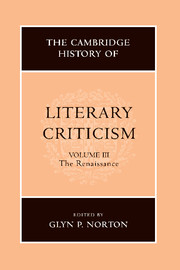Book contents
- Frontmatter
- Introduction
- READING AND INTERPRETATION: AN EMERGING DISCOURSE OF POETICS
- POETICS
- I Humanist classifications
- II The rediscovery and transmission of materials
- III Rhetorical poetics
- 13 Humanist education
- 14 Second rhetoric and the grands rhétoriqueurs
- 15 The rhetoric of presence: art, literature, and illusion
- 16 The paradoxical sisterhood: ‘ut pictura poesis’
- 17 Conceptions of style
- 18 Sir Philip Sidney's An apology for poetry
- 19 Aristotle, Horace, and Longinus: the conception of reader response
- IV Literary forms
- THEORIES OF PROSE FICTION
- CONTEXTS OF CRITICISM: METROPOLITAN CULTURE AND SOCIO-LITERARY ENVIRONMENTS
- VOICES OF DISSENT
- STRUCTURES OF THOUGHT
- NEOCLASSICAL ISSUES: BEAUTY, JUDGEMENT, PERSUASION, POLEMICS
- A SURVEY OF NATIONAL DEVELOPMENTS
- Bibliography
- Index
- References
15 - The rhetoric of presence: art, literature, and illusion
from III - Rhetorical poetics
Published online by Cambridge University Press: 28 March 2008
- Frontmatter
- Introduction
- READING AND INTERPRETATION: AN EMERGING DISCOURSE OF POETICS
- POETICS
- I Humanist classifications
- II The rediscovery and transmission of materials
- III Rhetorical poetics
- 13 Humanist education
- 14 Second rhetoric and the grands rhétoriqueurs
- 15 The rhetoric of presence: art, literature, and illusion
- 16 The paradoxical sisterhood: ‘ut pictura poesis’
- 17 Conceptions of style
- 18 Sir Philip Sidney's An apology for poetry
- 19 Aristotle, Horace, and Longinus: the conception of reader response
- IV Literary forms
- THEORIES OF PROSE FICTION
- CONTEXTS OF CRITICISM: METROPOLITAN CULTURE AND SOCIO-LITERARY ENVIRONMENTS
- VOICES OF DISSENT
- STRUCTURES OF THOUGHT
- NEOCLASSICAL ISSUES: BEAUTY, JUDGEMENT, PERSUASION, POLEMICS
- A SURVEY OF NATIONAL DEVELOPMENTS
- Bibliography
- Index
- References
Summary
Fascination with the idea of illusionist representation pervades the history of Renaissance culture. Great artists were generally convinced that they had been endowed with a power to instil a supernatural degree of life into their artefacts. The Pygmalion fantasy can be seen as emblematic of this faith in the illusionist qualities of art. The famous Greek myth exemplifies the belief in the power of art to give life rather than to represent it. In Ovid's version of the story Pygmalion is a sculptor who falls in love with the statue he has fashioned, and the gods answer his prayers by turning the cold marble into living flesh (Metamorphoses, x). This myth naturally captivated the imagination of many artists and writers from Donatello to Michel de Montaigne and William Shakespeare. The triumph of representational skill is traditionally associated with the power of art to arouse passions. This was still common theoretical currency in the Renaissance.
The painter could so subdue the minds of men that they would fall in love with a painting that did not represent a real woman. In his Treatise on painting Leonardo tells the following anecdote: ‘I made a religious painting which was bought by one who so loved it that he wanted to remove the sacred representations so as to be able to kiss it without suspicion. Finally his conscience prevailed over his sighs and lust, but he had to remove the picture from his house.’ If for today's critics illusionist virtuosity is suspect at best as a criterion of artistic worth, it was indeed highly praised by classical authority.
- Type
- Chapter
- Information
- The Cambridge History of Literary Criticism , pp. 161 - 167Publisher: Cambridge University PressPrint publication year: 1999
References
- 2
- Cited by



